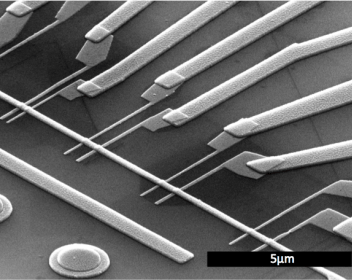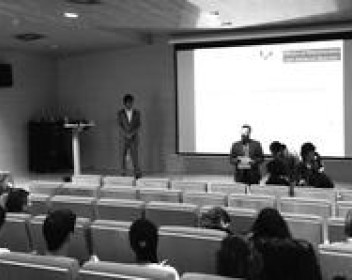Prentsa-bulegoa
Albisteak
CTECHnano, nahierarako konponbideak industriarentzat
- Irtenbide berriak garatzen ditu CIC nanoGUNEren ekimenez sortu den CTHECnano enpresak
- Materialen propietateak aldatzeko aukera ematen du ALD teknologiak (Atomic Layer Deposition)
- Material batek berariazko propietateak behar dituenean aplikatzen da teknologia hori
"Electrospinning of Biomolecules", PhD Thesis by Wiwat Nuansing
Wiwat Nuansing, Pre-doctoral Researcher in the Self-Assembly Group at nanoGUNE, received his Doctor Degree at the University of the Basque Country (UPV/EHU) after the defense of his thesis project on Monday 23 June 2014. He carried out his research work, entitled Electrospinning of Biomolecules, under the supervision of Dr. Alexander Bittner, Ikerbasque Research Professor and leader of the Self-Assembly group.
"Injection, Transport, and Manipulation of Pure Spin Currents in Metallic Lateral Spin Valves", PhD Thesis by Estitxu Villamor Lomas
Estitxu Villamor, Pre-doctoral Researcher at the Nanodevices Group at nanoGUNE, receives her PhD at the University of the Basque Country (UPV/EHU) after the defense of her thesis project on Monday 15 December 2014. Her research work, entitled “Injection, Transport, and Manipulation of Pure Spin Currents in Metallic Lateral Spin Valves”, has been developed under the supervision of the Nanodevices Group researcher and Ikerbasque Research Professor Dr. Felix Casanova Fernandez.
ETP Nanomedicine Annual Event 2014
NanoGUNE hosts more than 120 experts in nanotechnology and medicine at the 2014 Annual Event & General Assembly of the European Technology Platform on Nanomedicine (ETPN). The ETPN event has taken place on 15 and 16 October 2014, co-organized by the nanoBasque Agency (SPRI) and nanoGUNE, the Basque Nanoscience Cooperative Research Center.
2014 Ludwig-Genzel saria Rainer Hillenbrandi
* 2008az geroztik, nanozientzia ikertzeko euskal zentroa den CIC nanoGUNEko Nanooptika taldeko buru da Hillenbrand
* "Eremu hurbileko espektroskopia infragorriko diseinuagatik eta garapenagatik" eman ,diote saria, eta "metodo espetroskopiko berri horrek natura-zientzietako zenbait alorretan ,duen aplikazioagatik"
* Bi urtez behin ematen da Ludwig-Genzel saria. Materia kondentsatuaren espektroskopiaren alorrari
Sir John Pendry, nanozientziaren 2014 Kavli Saria
- Sir John Pendry Euskal Herriko DIPC eta CIC nanoGUNE ikerketa-zentroetako batzorde zientifikoetako kidea da
- Kavli Sariak teknologiaren Nobel saritzat jotzen dira
"Polythiophene-based nanoscale lateral devices", PhD thesis by Thales V. A. G. de Oliveira
Thales de Oliveira, Pre-doctoral Researcher at the Self-Assembly Group at nanoGUNE, received his PhD at the University of the Basque Country (UPV/EHU) after the defense of his thesis project on Friday 23 May 2014. His research work, entitled “Polythiophene-based nanoscale lateral devices”, has been developed under the supervision of Dr. Alexander Bittner and Dr. Luis E. Hueso, Ikerbasque Research Professors and Leaders of the Self-Assembly and Nanodevices Groups, respectively.
Grafeno-plasmoiak, argi-izpi bat belaunaldi berriko gailuetarako
- Antenetan oinarritutako plataforma teknologiko bat garatu dute CIC nanoGUNEko ikertzaileek, grafenoan zehar hedatzen den argia abiarazi eta kontrolatzeko aukera ematen duena. Aurkikuntza horrek bidea emango du gailu eta zirkuitu fotoniko oso miniaturizatuak egiteko.
- Frogatu dute grafenoan (zeina karbono-atomoen geruza bakarrarekin osatutako materiala baita) harrapatutako argia fokuratu eta kurbatu daitekeela.
- Lanaren berri Science zientzia-aldizkari entzutetsuan eman zuten atzo.
"Resistive switching in Hafnium oxide", PhD thesis by Raul Zazpe
Raul Zazpe, Pre-doctoral Researcher at the Nanodevices Group at nanoGUNE, received his PhD at the University of the Basque Country (UPV/EHU) after the defense of his thesis project on Wednesday 30 April 2014. His research work, entitled “Resistive switching in Hafnium oxide”, has been developed under the supervision of the Nanodevices Group Leader and Ikerbasque Research Professor Dr. Luis Hueso.
Abangoardiako teknologia mundu akademikoaren eta enpresen zerbitzura
Kanpo Zerbitzuen Departamentua jarri du martxan CIC nanoGUNEk, abangoardiako ekipamendua eta langile kualifikatuak uztartu, eta hezkuntzako munduari eta enpresei eskaintzen zaien zerbitzu integrala.
Ekitaldiak
- 2026/02/04 - 2026/02/06
nanoGUNE Winter School 2026
nanoTEKA
Aurkitu argazkiak, irudi esperimentalak, bideoak, audioak eta nanoGUNErenirudi korporatiboa.




